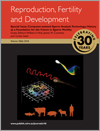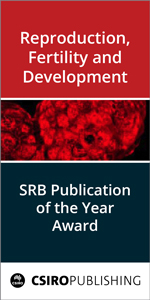
Reproduction, Fertility and Development
Volume 30 Number 6 2018
Computer-assisted Sperm Analysis Technology: History as a Foundation for the Future in Sperm Motility
RD17475Evaluation of sperm motility with CASA-Mot: which factors may influence our measurements?
In this paper we review the main factors that may affect the evaluation of sperm motility through computer-aided sperm analysis (CASA-Mot) related to the sample, slide, microscope, hardware, software and user. The take-home message of this article is that both commercial and non-commercial CASA systems are available, and all are appropriate for routine analysis. However, in all cases, standard protocols for evaluation and methods for system validation are required.
RD17432CASA-Mot in mammals: an update
Computer-aided sperm motility analysis systems have broad scientific and practical relevance. The sources of variation and current applications of these systems and their relationships with other sperm quality tests are discussed. There is still a great need for standardisation in many species, and future systems will probably be able to integrate several sperm quality parameters with motility.
RD17551CASA-Mot technology: how results are affected by the frame rate and counting chamber
Sperm analysis software includes some hardware technology that may affect motility parameters. The optimal combination of frame rate and counting chamber type and depth should be defined for each species and experimental condition. In general, 60 frames s−1 is considered the minimum satisfactory frame rate for sperm analysis, although technical conditions differ for different species.
RD17551 Abstract | RD17551 Full Text | RD17551PDF (595 KB) Open Access Article
RD17460Sperm motility in fish: technical applications and perspectives through CASA-Mot systems
Sperm motility is nowadays considered the best biomarker for fish spermatozoa, becoming a powerful and useful tool for aquaculture and ecological purposes. A high number of sperm kinetic parameters from more than 170 fish species has been reported in more than 700 scientific articles, covering a wide range of topics. This review provides an overview of the major research areas in which fish sperm motility assessment by computer-aided sperm analysis (CASA) has been used successfully.
RD17478Fish sperm motility analysis: the central role of the flagellum
Fish spermatozoon can reach egg and contribute to fertilization only due to motility phenomenon. This activity is provided by sperm flagellum, playing a double role: a motor and a propeller. A detailed analysis of the flagella performance is a key to the crucial information on qualitative characteristics of sperm and the mechanisms underlying both the spermatozoa movement per se and their targeted approaching towards the egg.
RD17476Making the most of sperm activation responses: experiments with boar spermatozoa and bicarbonate
In this article we show how exploiting the rapid (<5 s) stimulatory effect of bicarbonate on boar spermatozoa can be used experimentally to investigate how sperm motility is controlled by molecules of the female reproductive tract. This includes motility inhibition, which can most easily be measured after first using bicarbonate to induce maximal sperm activation. In a wider context, this approach lends itself to the development of sperm motility-based assays for toxicity testing in many different fields.
RD17520CASA in the medical laboratory: CASA in diagnostic andrology and assisted conception
Despite the existence of computer-aided sperm analysis (CASA) for many years, clinical use among ‘fertility laboratories’ remains limited, despite clear weaknesses in manual semen analysis. Early CASA systems failed to instil confidence and provide a reliable sperm count. However, recent CASA-Mot systems have been validated to provide sperm concentration, motility and velocity, and the benefits related to objectivity and reproducibility should be made clearer.
RD17479Implementation of novel statistical procedures and other advanced approaches to improve analysis of CASA data
Modern sperm analysis allows motility or morphometric data to be obtained for individual cells. However, advanced statistical analysis is needed to obtain useful information from these huge datasets. In this review we describe several statistical techniques that can be used for that purpose. We also make several recommendations to promote standardisation of the protocols for acquisition and analysis.
RD17420CASA: tracking the past and plotting the future
The human semen sample carries a wealth of information of varying degrees of accessibility; from the traditional visual measures of count and motility, to those that need advanced computing power. In this article we discuss the key attitudes towards technological advances, and the ways in which technology should (and should not) be used for the clinical analysis of human semen.
RD17420 Abstract | RD17420 Full Text | RD17420PDF (530 KB) Open Access Article
RD17468Current perspectives of CASA applications in diverse mammalian spermatozoa
Computer-aided sperm analysis (CASA) has become a powerful tool to quantitatively analyse sperm structure and function of almost any mammalian species. Fully automated analysis was used to describe and assess sperm motility and sperm morphology in primates, domestic animals, laboratory rodents and wildlife. The results provide novel baseline information to be used as standard sperm characteristics and highlight various research and clinical applications.
RD17472New objective measurements of semen wave motion are associated with fertility in sheep
The microscopic observation at low magnification of a drop of undiluted ram semen shows a collective motion of spermatozoa called wave motion and is used as a semen quality assessment. Objective assessment methods of semen turbulence based on optical flow and fluorescent bead motion showed similar efficiency as subjective wave motion score to predict fertility after insemination. This objective method of semen quality assessment could be used in species such as bovine, sheep, goat and domestic birds.
RD17466Comparison of sperm motility subpopulation structure among wild anadromous and farmed male Atlantic salmon (Salmo salar) parr using a CASA system
Fish species with high economic value has put pressure on the wild population. To guarantee the recovery of fish species, such as Atlantic salmon, it is necessary to study the sperm motility patterns from cultured fish and wild population. High proportions of fast spermatozoa with non-linear progressivity could be advantageous for successful fertilisation and selection of high-quality salmon breeders.
RD17466 Abstract | RD17466 Full Text | RD17466PDF (486 KB) Open Access Article
RD17470CASA in invertebrates
This study quantified sperm concentration and motility in primarily broadcast spawners in three invertebrate phyla using computer-aided sperm analysis (CASA). CASA technology was used to study sperm motility and quantitatively describe different helical swimming patterns found in the species studied. Baseline information regarding several motility characteristics of invertebrate species is provided, and related to the fertilisation biology in different micromarine environments.
RD17441Determining the relationship between bull sperm kinematic subpopulations and fluorescence groups using an integrated sperm quality analysis technique
The study of sperm subpopulations may have functional and practical implications. The possible association between kinematic and fluorescent sperm subpopulations was investigated in bulls, observing that the distribution of kinematic sperm subpopulations was different between the fluorescent sperm groups, although the correlation between them was low. There is still a great need for more integrative methods able to simultaneously evaluate different aspects of sperm integrity and functionality.
RD17467Effect of counting chamber depth on the accuracy of lensless microscopy for the assessment of boar sperm motility
A new lensless microscopy device (ISAS®3D-Track) allows three-dimensional evaluation of sperm motility. When used with boar semen, ISAS®3D-Track results showed satisfactory correlation with those obtained using the classical optical CASA-Mot system. Velocity parameters obtained with the ISAS®3D-Track system were higher with increasing chamber depth, indicating a more natural and free movement of spermatozoa.
RD17467 Abstract | RD17467 Full Text | RD17467PDF (510 KB) Open Access Article



